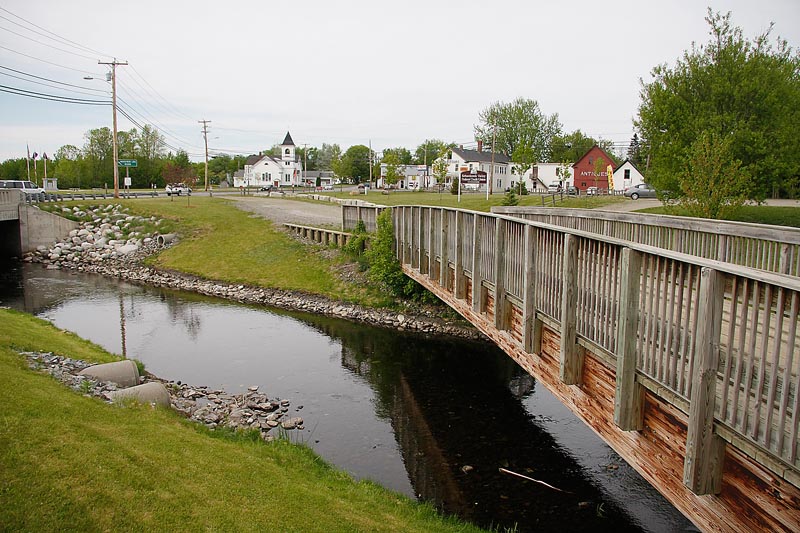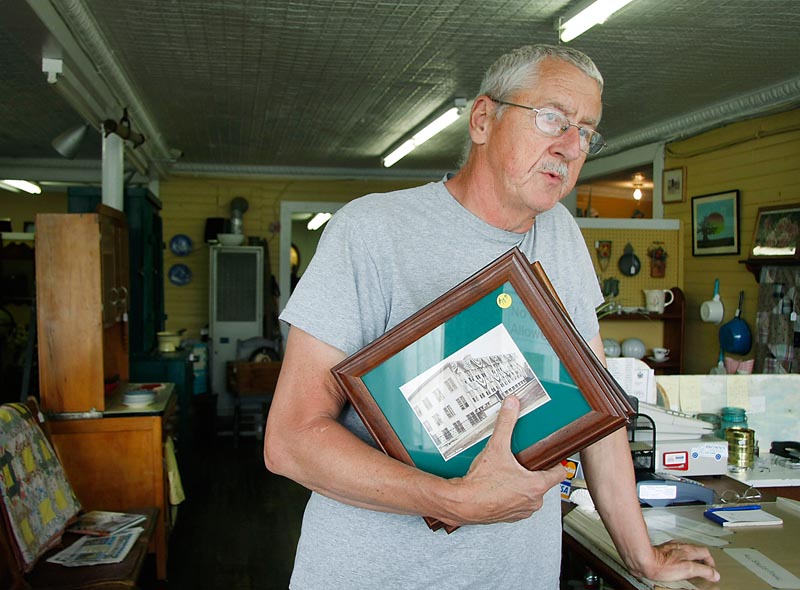CORINNA — Two gas stations, a seafood restaurant and a car wash line the approach to downtown Corinna. But then the commercial development on Route 11, the main street, abruptly stops.
Something is missing here.
Ten years after the Eastland Woolen Mill and much of downtown were demolished as part of the cleanup of one of the state’s worst Superfund sites, Corinna is still working to get its village back. The town has been peddling a half-dozen prime downtown commercial building lots where the mill once stood – but so far there have been few takers.
“Right now,” said Dalton Mullis, town manager and a 65-year Corinna resident, “we just have a lot of open park space.”
The effects of decades of contamination from the chemicals used by the mill to process wool have not been erased, even after a decade of cleanup work. At a meeting last week, Environmental Protection Agency officials told residents that while toxic chemicals in the soil, groundwater, the bed of the East Branch of the Sebasticook River and Sebasticook and Corundel lakes have been greatly reduced, the contamination may never completely go away.
“In the next five years, we will make the decision about whether to proceed (with more cleanup) or just accept that where it is now is as good as it will get,” said Ed Hathaway, an official who has managed the EPA cleanup since its inception.
The contamination was discovered in 1983, after an employee of the state Department of Environmental Protection happened to stop for lunch at Gallinson’s Place, a local restaurant, and got a whiff of the well water being served from the tap. It had a strong chemical odor.
But it wasn’t until 1996, when the mill went out of business, that the full extent of the contamination was discovered.
Built in the 1800s, the mill was purchased in 1936 by the Eastland Co., owned by the Striar family of Bangor. Over the years, the mill went through several expansions, creating a sprawling complex of buildings across 21 acres.
At its peak, the business – the town’s largest employer – employed more than 400 people working three shifts six days a week, and it accounted for 20 percent of the town’s tax base.
The manufacturing process involved mixing dyes with the solvent chlorobenzene. The wool was then soaked in vats of the chemical mixture.
When the solution was spent, it was dumped into the river. The mixture also seeped into the groundwater from leaky underground tanks and pipes.
As the pollution spread, DEP installed carbon filters on about a dozen wells in the village. The mill paid for a public water system to be installed in 1995.
By then, Eastland’s business was faltering badly, like other textile operations in New England. The mill closed in 1996, and the village’s hardware, auto parts and grocery stores soon followed.
Owed $90,000 in taxes, the town took over the property. Residents were so upset they changed the name of the local school from Eastland to Corinna Elementary.
“You won’t find much good will towards them,” said Ken Dow, a lifelong resident of Corinna whose website, www.cattailpress.com, chronicled the mill’s demolition.
Mixed with the anger was a lot of sadness, said Dow. Many Corinna residents had worked in the mills their entire adult lives at jobs that supported middle-class lifestyles.
“It was one of the few places in the ’40s, ’50s and ’60s where women would earn as much as men,” said Dow.
Once testing revealed the extent of the contamination, the town was easily convinced that it should become a Superfund site. Officials took advantage of the federal and state funding available to tear down the vacant and deteriorating buildings, remove the toxic chemicals and redevelop the site.
“The EPA was like the cavalry coming over the hill,” said Dow.
The building demolition began in 2000. Three years later, most of the cleanup was complete. A sharp curve on Main Street was removed, the river was diverted and 150,000 tons of soil taken away.
Since then, cleanup workers have been injecting an oxidizing reagent into the ground to destroy the toxins. The treatment has cut the contaminated area in half. Hathaway was able to report to residents last week that with 90 percent of the contaminated soil now removed, most of the 21-acre site probably can be deleted from the list of Superfund properties within the year.
There will be permanent restrictions on the land, however. No one will be allowed to remove soil from the former mill site or use it as a source of drinking water.
Eventually the test-well heads that now protrude from the ground will be removed, the fencing will come down and a trailer on the site will disappear, Hathaway told residents at the meeting.
The cost of the cleanup, originally estimated at $20 million, is now approaching $50 million, with the state picking up $1.25 million of the tab. The rest is coming from the federal government.
Hathaway also reported that the site is perfectly safe to walk over and play on. Fish are no longer showing signs of contamination from pesticides the mill used to protect the wool from insects.
“How about the fiddleheads?” asked Vivian Davis at the meeting. Davis, who worked at the mill for 25 years, said her friends worry that eating fiddleheads growing near the mill site will make them sick.
Hathaway assured her the fiddleheads are safe.
With the cleanup winding down, the imminent removal of much of the site acreage from the Superfund list and the economy picking up, some are hopeful new businesses will move in soon.
Corundel Commons, a residential project for the elderly, was built on one of the former mill lots four years ago. Resident Kay Gray said she is hoping the Sebasticook Valley Regional Federal Credit Union will move ahead with the use of a lot on which it took an option a year ago.
“We want a quaint village, no McDonald’s,” Gray said.
She points to signs of new economic life in the town, which hopes to reinvent itself as a tourist stop along the road linking Interstate 95 at Newport with Moosehead Lake. The new Red Roof Candy and Gift Shop opened, and the Harmony Home Decor store is expanding. But whether the doctors’ offices and banks the town envisions will move in remains uncertain.
Charles Colgan, an economist at the Muskie School of Public Service at the University of Southern Maine, said that “the only justification for Corinna as an urban center is the mill.”
Fourteen years after the Eastland’s closure, its employees have moved on, some of them to service jobs at the restaurants and retail stores that sprouted up around the I-95 interchange in Newport. Others make the 40-minute commute to Bangor or the 50-minute commute to Waterville.
The site has become the subject of study at Nokomis Regional High School in Newport. A group of seniors were at last week’s meeting to get the latest information for a project they are working on. They say they can barely recall the mill.
“I can remember the water tower being taken down,” said MacKenzie Smith, 18, of Corinna.
While some residents say getting rid of the cancer-causing chlorobenzene was worth the demolition of the village, others say the town will never be the same.
“I miss the little town we used to have, the stores and the convenience. Now we have nothing,” said Alice Guay, who worked as a billing clerk for more than 20 years.
Don Engstrom of Dixmont, who worked at the mills for a year right out of high school and is now employed part-time at Traditions, a Corinna antiques mall, said he remembers when the village bustled with people and traffic in the 1970s.
“This was a sweet little town,” Engstrom said.
Staff Writer Beth Quimby can be contacted at 791-6363 or at: bquimby@pressherald.com
Send questions/comments to the editors.






Success. Please wait for the page to reload. If the page does not reload within 5 seconds, please refresh the page.
Enter your email and password to access comments.
Hi, to comment on stories you must . This profile is in addition to your subscription and website login.
Already have a commenting profile? .
Invalid username/password.
Please check your email to confirm and complete your registration.
Only subscribers are eligible to post comments. Please subscribe or login first for digital access. Here’s why.
Use the form below to reset your password. When you've submitted your account email, we will send an email with a reset code.